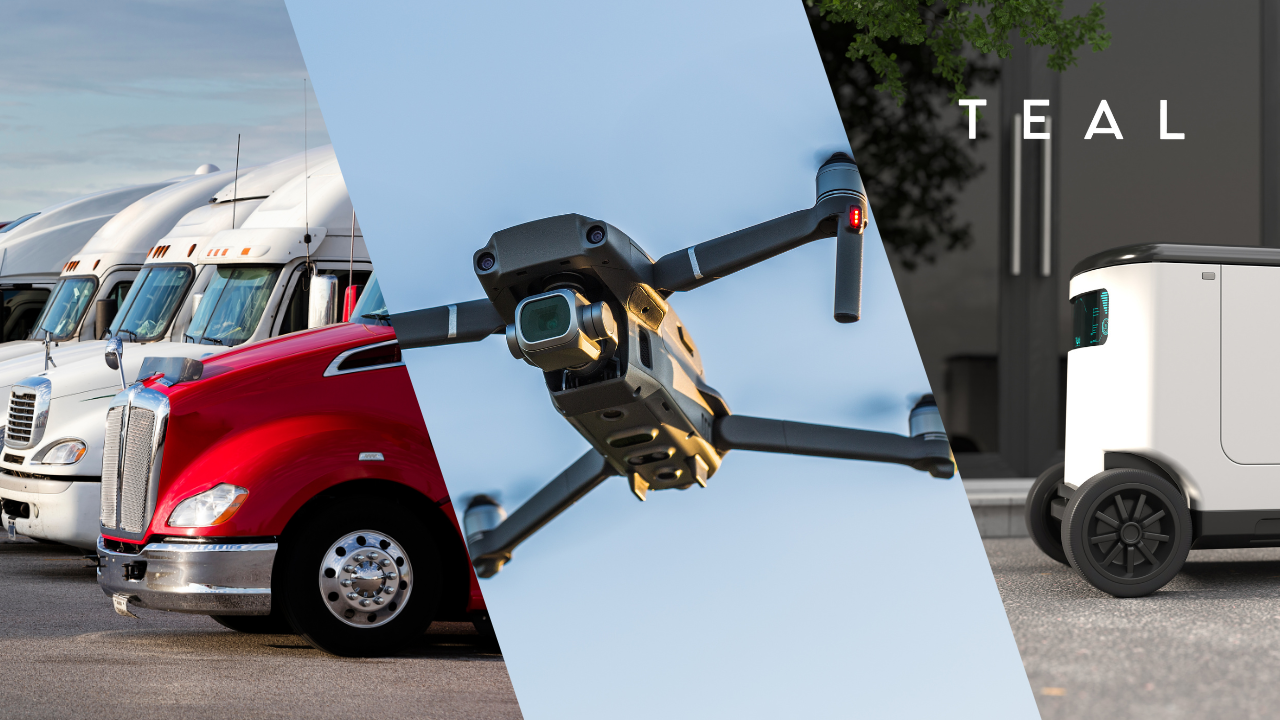The Only Connectivity Choice for High-Data Use Cases: The Rising Dominance of eSIM

Why eSIM is the only connectivity choice for these high-data use cases.
In an age where rapid data transfer is more than a commodity, the way we connect mission critical devices is more important than ever. Among the plethora of connectivity solutions, eSIM has emerged as the preferred choice for industries that rely on high data throughput and low latency for mission critical use cases.
In this comprehensive breakdown, we’ll explore why eSIM technology is becoming the quintessential link for data-heavy applications such as Beyond Visual Line of Sight (BVLOS) Drone Operations, Autonomous Robot Delivery, and Fleet Management Solutions.
Rising to the Challenge in BVLOS Drone Operations
Drone technology has ascended to the skies and is now heavily relied upon for public safety and military applications. Beyond drone-as-a-first-responder applications, BVLOS drones are integrating into everyday commercial operations and surveillance missions. But as drones move from novelty flights to mission-critical ventures, their connectivity struggles come into sharp focus. Traditional SIM cards offer limited global reach, often tying users to a single network. This can be problematic for drones operating around the world, especially when they are flying missions beyond an eight-mile radius.
The Teal eSIM solution has revolutionized BVLOS drone operations by providing a single, programmable SIM card that tackles the industry’s core challenges:
- Global Connectivity Without the Headache: Managing multiple carrier agreements and roaming services has traditionally been an accounting labyrinth. TEAL eSIM simplifies it — one eSIM SKU, give your access to connect onto any network, anywhere in the world.
- Latency and Throughput: For BVLOS drones that require real-time, low-latency data transfer, Teal’s eSIM outperforms regular roaming services, ensuring a safer, more responsive unmanned flight experience. How? Because TEAL is the only connectivity solution that can provide native core connectivity onto leading networks worldwide without roaming. The result is higher reliability and better performance.
- Range and Redundancy: Drones that stretch beyond the line of sight can’t afford connectivity dead zones. TEAL enable dynamic switching between data networks allowing for redundancy across networks and guaranteeing the coverage and reliability that missions demand.
- Easy Deployment: Traditional SIMs have been a deployment bottleneck. With TEAL, the process is faster and more streamlined, allowing drone operators to get airborne with minimum fuss.
By adopting Teal’s eSIM, BVLOS operations have reported massive cost savings and unparalleled deployment efficiency, catapulting the technology to the forefront of this burgeoning industry. Learn more about how leading companies are leveraging TEAL’s eSIM capabilities for global BVLOS drone operations in this video:
Navigating the Urban Jungle with Autonomous Robots
Autonomous robots are altering last-mile delivery solutions but are also facing their own set of connectivity intricacies. Encouraging the seamless integration of these robots into our urban landscape requires a connectivity solution that’s as versatile as it is robust. On campuses and in cities, robots are traveling in a wide-open environment with a lot of buildings and reflections. WiFi can’t be relied on because it’s too short range, and 4G has issues around people and large buildings where there are a lot of dead zones, especially low to the ground where delivery robots operate. There needs to be backups and a flexible solution like TEAL gives autonomous robots the ability to dynamically switch between data networks when needed, over-the-air. Moreover, robots in these urban environments need access to connect onto native core networks to ensure the lowest latency and highest throughput. In short, these robots need to be reliably connected at all times to ensure that deliveries are completed on time and to the right destinations.
Enter TEAL’s eSIM technology for Autonomous Robotics. Companies like Starship, pioneers in the field, have found a reliable partner in eSIM technology. True eSIM provides the following benefits:
- Eliminates complexities of working with multiple MNO’s
- Has better throughput with lower latency
- Enables programmable access to native core networks
- Provides the ability to switch dynamically between networks
The result is not just a reduction in operational complexity, but a significant enhancement in performance metrics like latency and throughput that are vital in city environments.
Check out the video below to find out how TEAL is enabling global robot delivery on a global scale:
Streamlining Operations in Fleet Management
Fleet management and telematics are synonymous with the need for constant, high-volume data exchange. TEALs eSIM technology has found its sweet spot in revolutionizing how fleet operators manage their assets on a global scale, freeing them from the shackles of single-carrier alternatives and the false promises of roaming solutions.
- Real-Time Data Demands: The need for vehicles to communicate critical information in real time is paramount. TEAL’s eSIM technology ensures that telematics solutions are always connected to the best networks available, without the latency and throughput hiccups of traditional roaming services.
- Multi-Network Flexibility: To cope with the geographic diversity of fleet operations, Teal’s eSIM allows dynamic switching between different networks, ensuring a seamless and uninterrupted data flow.
- Native Core Connectivity: Teal’s eSIM is the only connectivity solution that can provide native core connectivity onto America’s three tier-1 carrier as well as providing core connectivity onto networks in Canada, Mexico and the EU.
The convenience of a single eSIM SKU granting multiple network access (especially native core networks access) has simplified fleet connectivity management, reducing operational complexities and cutting down on costs significantly. Find out how TEAL is helping Safe Fleet a leading telematics provider achieve its goal to help its customers reduce preventable accidents across their fleets. Safe Fleet product lines include advanced technology, mobile video surveillance, fleet management and advanced collision avoidance systems. Connected by TEAL, these products form an integrated platform to help predict and prevent accidents, create better drivers, smarter vehicles and safer fleets. Check out the case study here: eSIM For Safe Fleet
Why MVNO Solutions Aren’t Ideal for High-Data IoT
An MVNO is a network provider that rents airtime (radio network) from the MNOs but adds a virtual data network for the actual throughput. Connections to this network first go through an MNO tower, then an MVNO datacenter. Many MVNOs claim that they are connectivity platforms or that they provide a global SIM, but because they are renting their platform, it means that you’re stuck with a static, limited solution and any changes are reliant on a 3rd party. With Teal’s patented and wholly-owned eSIM platform, IoT companies can develop features and functionality without 3rd party reliance, which translates into faster go-to-market capabilities.
An MVNO still operates a virtual network. They still operate datacenters and provide a rough copy of the data architecture of the original MNO network. At first, they look easy to join and may even seem cost effective, but then they fall short when roaming agreements are suddenly blocked or when they experience higher latency due to reduced datacenter capacity.
MVNOs will assert that they offer carrier-switching, but the reality is that they only switch you between towers while datacenters remain the same. In many cases, the identity stays the same as well. Why is this bad for IoT companies? Mainly because MVNOs don’t offer redundancy and remain a single point of failure.
IoT devices that are connected onto away networks are not prioritized. This means that in some cases you may experience great performance, but in many other instances, performance will be degraded, and latency will be high. This unreliability in network speeds and availability is not ideal for most mission critical high-data applications such as video surveillance, fleet management (telematics) solutions, autonomous robotics and BVLOS drones. So, while it might seem like you are getting great global coverage at competitive rates, the reality is that your mission critical devices are put at risk and will likely experience less than advertised performance.
Contrarily, native core connectivity is purpose-built for IoT and M2M devices, ensuring consistent, high-quality service, and response, irrespective of location. The costs associated with core connectivity are also more predictable, given the absence of unexpected roaming charges, which can be detrimental to the financial health of a business. Overall, the return on investment with native core networks stands out due to the performance gains and the ability to maintain better control over connectivity infrastructure.
Diving Deeper into the eSIM Revolution
The introduction of eSIM technology has ushered in a new era for IoT and M2M connectivity, promising unparalleled flexibility and simplified network management. By adopting eSIM, businesses can circumvent several limitations associated with traditional SIM cards, such as the need for physical swapping, vendor lock-in, and the logistical challenges of managing multiple contracts across various carriers.
Some MVNOs claiming to be eSIM platforms are really only offering multi-imsi solutions that don’t offer the same freedom and flexibility that true eSIM technology offers.
eSIM empowers devices with the agility to switch seamlessly between networks, with TEAL leading the charge and offering native connectivity onto America’s three Tier 1 carriers, along with support for carriers in other countries. This level of versatility coupled with robust data security infrastructures makes eSIM the definitive choice for businesses that wish to maximize the potential of their IoT and M2M investments.
The Unstoppable Rise of eSIM
The connectivity requirements of high-data use cases such as BVLOS drone ops, autonomous robot delivery, and fleet telematics are no longer the domain of standalone SIM cards or roaming solutions. The eSIM technology offered by Teal has emerged as the superior solution, addressing the stringent demands of these industries with a combination of versatility, performance, and ease of integration.
For tech innovators, robotics engineers, telecommunications professionals, and all those pushing the frontiers of connectivity, the message is clear—when it comes to high-data use cases, eSIM is not just the best option; it’s the only option.
In a world where everything must be connected, everywhere, eSIM technology is stepping up to the plate as a pivotal enabler. It’s not just about being connected; it’s about being connected to the right data networks, every time. With TEAL’s eSIM at the helm, industries are not just navigating the data tides—they’re riding them towards a brighter, more connected future. So, embrace the eSIM revolution, and join us in shaping the world of tomorrow.
Don’t take our word for it! Find out why the leading companies across robotics, drones, telematics, video surveillance and EV charging infrastructure rely on TEAL’s eSIM. Check out our case studies here: https://tealcom.io/case-studies
Interested in finding out how eSIM can help your business?
📅 Contact us today to schedule a time to speak with one of our experts
👉 https://tealcom.io/schedule-meeting
Recent Posts
TEAL’s Network Orchestration Service (NOS) is Changing Cellular Connectivity
Teal Communications Staff2025-07-15T19:59:45+00:00
How TEAL’s eSIM Technology is Shaping the Future of Drone AAM Policy Under FAA Part 108
Teal Communications Staff2025-07-08T16:48:15+00:00
Empowering Freedom, Independence, and Control Through TEAL’s Network Orchestration Service (NOS)
Teal Communications Staff2025-07-03T16:40:46+00:00




